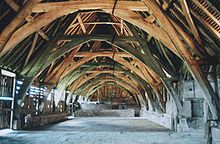Cruck
The cruck is a wooden construction element in English roof and framework constructions .
“Cruck” is probably best translated as “wooden belt arch” (cruck = arched brace).
Two opposing cruck arches create the image of a pointed arch that resembles a Gothic stone pointed arch, but sometimes also a basket or flat arch.
The "cruck" is traditionally found in barns, stables and half-timbered buildings all over Europe and can also form a continuous strut from the floor to the ridge ( full or true cruck ).
In the English Gothic and then in the Tudor style , it was taken up again to create a combination of masonry and wooden vaults.
The “wooden belt arch” is often supported on the outer walls in such a way that it uses them as a support and leaning surface at the same time, as its lower end is pulled deep into the wall area. This increases the stability of the structure , but also introduces transverse forces into the outer wall, which must be taken into account in the construction.
Usually a collar beam ties the upper ends of the belt arches together. The Hammerbeam roof ( hammer beam roof ) of the English Gothic and Tudor style allows far supporting roof constructions without passing through collar beams remain of which only nor the short tails.
